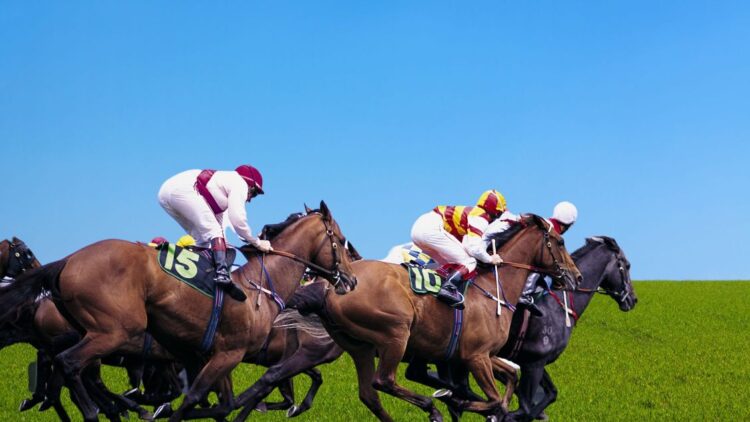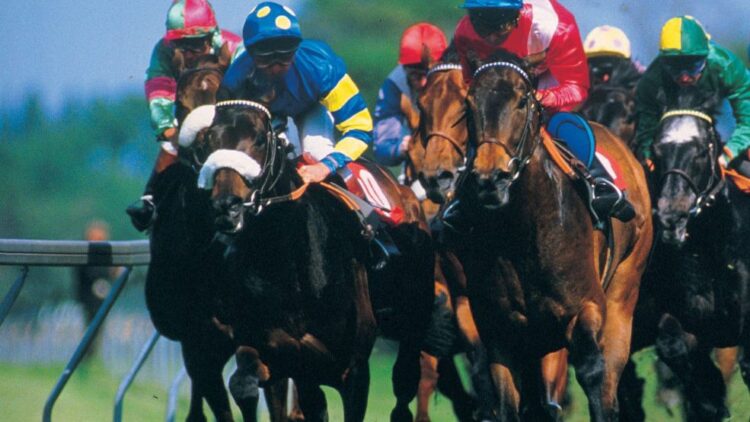
OBJECTIVE OF HORSE RACING: Be the first to cross the finish line while on horseback.
NUMBER OF PLAYERS: 2+ players
MATERIALS: Saddle, reins, whip, helmet, goggles
TYPE OF GAME: Sport
AUDIENCE: 18+
OVERVIEW OF HORSE RACING
Horse racing is an equestrian sport that simply involves riders (known as jockeys) competing against each other around a track on horseback. Despite equestrian sports often paling in popularity compared to other major sports, major horse racing competitions, such as the Kentucky Derby, still attract millions of viewers every year. In fact, the 2023 Kentucky Derby attracted a TV audience of 14.8 million people, making it one of the most-watched stakes race events on TV!
Historically, this sport has deep roots in many ancient civilizations, namely in Ancient Greece, Rome, Syria, and Egypt. Some of these civilizations even expanded the sport to include chariot racing. About 2,000 years later, in the late 1600s, Britain’s nobility revitalized the sport, bringing it back to prominence in the Western world.
Due to the technological advancements that rendered horses an obsolete part of military training, it is thought that many horse riding skills would’ve been long forgotten had they not stayed relevant in horse racing.
SETUP

EQUIPMENT
- Saddles: A seat (often leather) placed on the horse’s back and used by the rider.
- Reins: Used to help control and maneuver the horse.
- Whip: Occasionally used to encourage the horse to move faster.
- Helmet: Worn to protect the rider from head trauma.
- Goggles: Worn to protect the rider’s eyes from rocks and mud kicked up by other horses. On extra muddy tracks, some riders will even wear 3-5 pairs of goggles on top of each other, taking a layer off each time their vision becomes too obscured by mud.
HORSES
The extreme emphasis placed on horse breeding and training is one of the main reasons why horse racing is incredibly difficult and expensive to get into. Just about every race restricts entry to only a specific breed of horse, the main ones being:
THOROUGHBRED
All Thoroughbred horses in existence have a bloodline that traces back to three male horses from the early 1700s. This is an extremely prestigious breed of horse, and no unnatural means of reproduction are allowed (cloning, embryo transfer, etc.). Thoroughbreds are known for possessing a desirable mix of speed and endurance. Thoroughbred racing such as the Kentucky Derby only allow Thoroughbred horses to race.
STANDARDBRED
Standardbred horses descend from thoroughbreds and are considered to be quite versatile. They are best known for being extremely docile and rarely spooked. These horses are most often used in harness horse racing.
ARABIAN
Arabian horses are known for having remarkable levels of endurance, mostly due to having a majority of type I muscle fibers. Because of these endurance traits, Arabian horses are the breed of choice in endurance races, although they’re also often used in traditional track races.
QUARTER
Quarter horses were mainly developed to help farmers with plowing and cattle work. This led to them becoming extremely muscular and compact. With a large majority of type II muscle fibers, Quarter horses are generally considered to be the fastest and most explosive sprinting breed over short-distance races.
HANDICAP BASED ON WEIGHT
Despite most horse races consisting of one breed of horse, many races will implement a “handicap” system to create an even playing field. This is often done by adding weight to a horse based on its age, with more mature horses having to carry a heavier load than younger horses. These restrictions are set by a racing secretary, and create allowance race for certain horses.
GAMEPLAY

EVENTS
While most people only think of horse races that involve an oval-shaped track, there are actually four different prominent horse racing events that athletes compete in today. These horse racing terms include:
- Flat Racing: The traditional form of horse racing in which horses race on a straight or oval-shaped track, with a flat racing surface.
- Jump Racing: Also known as steeplechasing, these races involve the horses compete by having to leap over obstacles.
- Harness Racing: These races involve the horses pulling the rider behind them in a two-wheeled cart known as a “sulky”.
- Endurance Racing: These are cross-country races that often range in distance from 25 to 100 miles.
Like most other types of races, the horse and rider first to cross the finish line win in each of these events.
HORSE TRAINING
While breeding often takes the spotlight when it comes to the physical qualities of a horse, they’re also heavily reliant on knowledgeable teams of trainers to prepare them for competitions. Generally, training plans are constructed for horses in a similar way to humans; the training plan must consider the type of race the horse is being prepared for, the horse’s genetics, and the horse’s recovery and motivation.
If a horse is trained too intensely, it becomes very susceptible to injury and even a lack of motivation, making it unwilling to learn. Since most horses are not fully grown until they are between four and six years of age, injuries are very difficult to avoid due to their undeveloped skeletal structure. This makes the job of a horse trainer all the more important to maximize the physical adaptations of the horse while still keeping them healthy both physically and mentally.
RIDING TECHNIQUE
Throughout a race, especially near the final sprint to the finish line, you may notice that the jockeys almost begin to stand with their feet in the stirrups. This technique helps the horse become more aerodynamic, as the rider takes their weight off the horse’s back and instead shifts much of it to their feet in the stirrups, having their own legs take on some of their body weight.
HORSE RACING GAMBLING SCENE
It is unlikely that this sport would remain as popular as it is today if it wasn’t for the money associated with it. Likely reaching all the way back to ancient times, gambling and betting on which horse will win is a deeply engraved part of the culture. In fact, it is estimated that more than 100 billion dollars are generated each year from people gambling and betting on horse races.
END OF GAME
The horse and rider that are first to cross the finish line are the winners, no matter what type of horse race it is.
- 30 GAMES TO PLAY OVER TEXT - April 22, 2024
- 20+ FREE PRINTABLE BABY SHOWER GAMES - April 16, 2024
- 20+ College Party Games for the Best Night Ever! - April 2, 2024